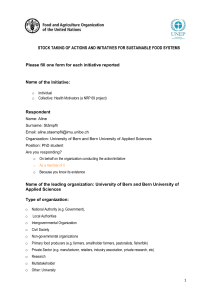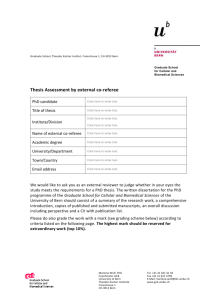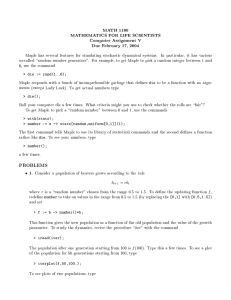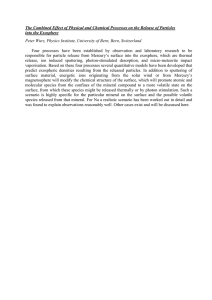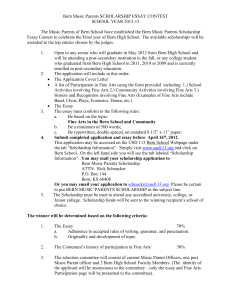Does competition stimulate innovation and productivity in Dutch retail trade?
advertisement
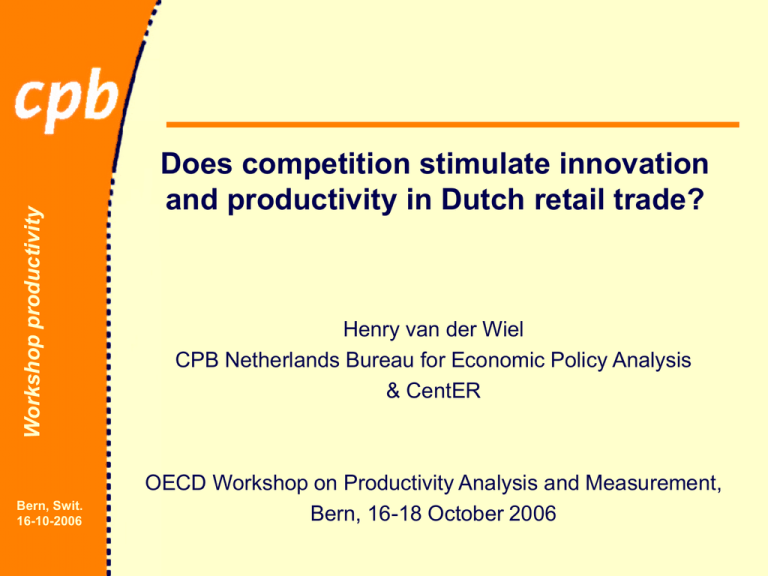
Workshop productivity Bern, Swit. 16-10-2006 Does competition stimulate innovation and productivity in Dutch retail trade? Henry van der Wiel CPB Netherlands Bureau for Economic Policy Analysis & CentER OECD Workshop on Productivity Analysis and Measurement, Bern, 16-18 October 2006 Outline Workshop productivity Introduction/background Relation competition and innovation 2 research questions Model for innovation and productivity Data and empirical results Bern, Swit. 16-10-2006 Concluding remarks Background (I) Dutch retail trade on its return? Workshop productivity ► Missed strong productivity growth of US since mid 1990s ► Gradually losing its strong position in EU since end of 1980s Labour productivity (per hours worked) relative to EU-average (EU=100), 1979-2002 Bern, Swit. 16-10-2006 Source: GGDC,2005 Workshop productivity Background (II): lack of competition and innovation? Bern, Swit. 16-10-2006 General belief that competition may stimulate productivity => static efficiency ► lower price margins ► efficient production (less X-inefficiencies) Likewise, innovation enhances productivity (growth) => dynamic efficiency Dutch policy measures in 1990s focussed on more competition ► New Competition Act in 1998 ► Regulatory reforms in retail trade => longer opening hours (1996) Competition and innovation: negative or positive? Workshop productivity Negative relationship: ► Standard IO literature and most (early) endogenous growth models ► Schumpeter model: competition reduces monopoly rents and thus the expected pay off from innovation Positive relationship: mostly based on empirics ► Paper of Nickell (1996): competition is good for innovation New development => inverted U-shaped curve ► Combining both theoretical ideas Bern, Swit. 16-10-2006 ► Empirically supported by Aghion et al. (2005, QJE) for UK Competition and innovation: inverted U-curve? Inverted U: composition effect Workshop productivity ► Weak competition: Bern, Swit. 16-10-2006 – industry is relatively often in a level state => – increase in competition stimulates innovation by the "escape" effect ► Intense competition: – industry is often unlevelled=> – increase in competition reduces innovation because there is little incentive for laggards to catch up Two questions Workshop productivity I. Bern, Swit. 16-10-2006 II. Did competition affect innovation in Dutch retail trade? Did competition and innovation contribute to productivity growth in this industry? Conclusion: more competition in Dutch retail trade stimulates both innovation and productivity growth Outline Workshop productivity Introduction/background Relation competition and innovation 2 research questions Model for innovation and productivity Data and empirical results Bern, Swit. 16-10-2006 Concluding remarks Basic idea of CIP-model Workshop productivity Assume no feedback from P to C or from I to C Competition (C) Static efficiency Inverted U-curve? Productivity (P) Innovation(I) Dynamic efficiency Bern, Swit. 16-10-2006 Workshop productivity CIP-model Bern, Swit. 16-10-2006 Presentation only focuses on results for innovation and productivity Skip model for explaining competition (in paper!), but not how to measure competition See also Creusen, Minne and Van der Wiel, 2006, in De Economist, September How to measure competition Workshop productivity We introduce a new measure, relative profits measure (RPM): Bern, Swit. 16-10-2006 ► based on intuition that in a more competitive market, firms are punished more harshly for being inefficient Firms differ in efficiency in terms of marginal costs (or productivity level). ► Cost advantages lead up to higher profits We estimate for an industry the following elasticity: percentage increase in profits due to a 1 percent increase in efficiency Workshop productivity Cons traditional measures competition Bern, Swit. 16-10-2006 Conventional ways of measuring competition (concentration (H) and price cost margin (PCM)) are not robust from a theoretical point of view Problem with H is that more aggressive conduct forces inefficient firms out of the market thereby increasing concentration ► It incorrectly suggests that competition is reduced As conduct becomes more aggressive, market share is reallocated from inefficient firms (with low PCM) to efficient firms (with high PCM) which tends to raise industry wide PCM ► It incorrectly suggests that competition is reduced Innovation: model Workshop productivity Explanation of innovation: inn = α0 + α1 RPM + α2 RPM 2 + βms with inn log innovation rate (firm level) RPM ms competition indicator (5-digit industry level) log market share (firm level) Expectations ► If inverted U: α1 > 0 and α2< 0 ► Scale effect: β > 0 Bern, Swit. 16-10-2006 Productivity growth: model Workshop productivity Simple Cobb Douglas function: Bern, Swit. 16-10-2006 ► Split TFP-growth in contribution of competition and innovation Explanation of labour productivity growth: Δp = γ0 + γ1 ΔRPM + γ2 INN-1 + γ3 (Δk - Δl) + γ4 Δl ───────┬──────── TFP-growth with Δp labour productivity growth (firm level) (Δk - Δl) capital intensity (firm level) Δl labour (economies of scale, firm level) Outline Workshop productivity Introduction/background Relation competition and innovation 2 research questions Model for innovation and productivity Data and empirical results Bern, Swit. 16-10-2006 Concluding remarks Data and method Workshop productivity Firm-level data ► Two sources of Statistics Netherlands – CIS-innovation surveys: 1996,1998 and 2000 – Annual surveys ‘Production Census’:1993-2002 ► Matched both sources – Number of observations ≈1150 Regression methods: ► Innovation based on TOBIT I-method Bern, Swit. 16-10-2006 – Innovation outlays left censored: no innovation in 75% of firms ► Productivity based on OLS Innovation results (I) Estimation results of quadratic model (Tobit-I model) Workshop productivity Determinant Estimate T-value Intercept −0.07 −1.76 Competition −0.05 −1.50 Competition 2 0.02 2.22 Market share 0.24 4.59 Scale parameter a Number of observations Left-censored observations 21.65 No inverted U-relation !! Log-likelihood Source: own calculations based on PS- and CIS-data a Scale parameter in the distribution used to normalize the underlying variable Bern, Swit. 16-10-2006 1147 864 70.46 Innovation results (II): simplified model Workshop productivity Estimation results of linear model innovation (Tobit-I model) Determinant Estimate t-value 0.14 -9.08 Competition 0.02 4.31 Market share 0.24 5.14 Intercept Scale parameter a Number of observations Left-censored observations Log-likelihood Bern, Swit. 16-10-2006 Source: own calculations based on PS- and CIS-data a Scale parameter in the distribution used to normalize the underlying variable 0.10 1147 864 72.9 Productivity growth results Workshop productivity Estimation results productivity, 1997-2001 a Bern, Swit. 16-10-2006 Determinant Estimate T-value Competition 0.07 1.91 Lagged innovation 0.01 2.19 Capital intensity 0.22 12.95 Labour (economies of scale) 0.00 0.45 Intercept 0.02 0.61 R-squared 0.17 Number of observations 883 Source: own calculations based on PS- and CIS-data a Incorporated years: 1997, 1999, and 2001, due to limited availability of innovation data Concluding remarks Workshop productivity No inverted U-relationship in Dutch retail trade! ► positive relation between competition and innovation Both competition and innovation have a positive impact on productivity growth So more competition in Dutch retail trade may stimulate productivity growth ► in the short term by reductions in X-inefficiency Bern, Swit. 16-10-2006 ► in the longer term by innovation
